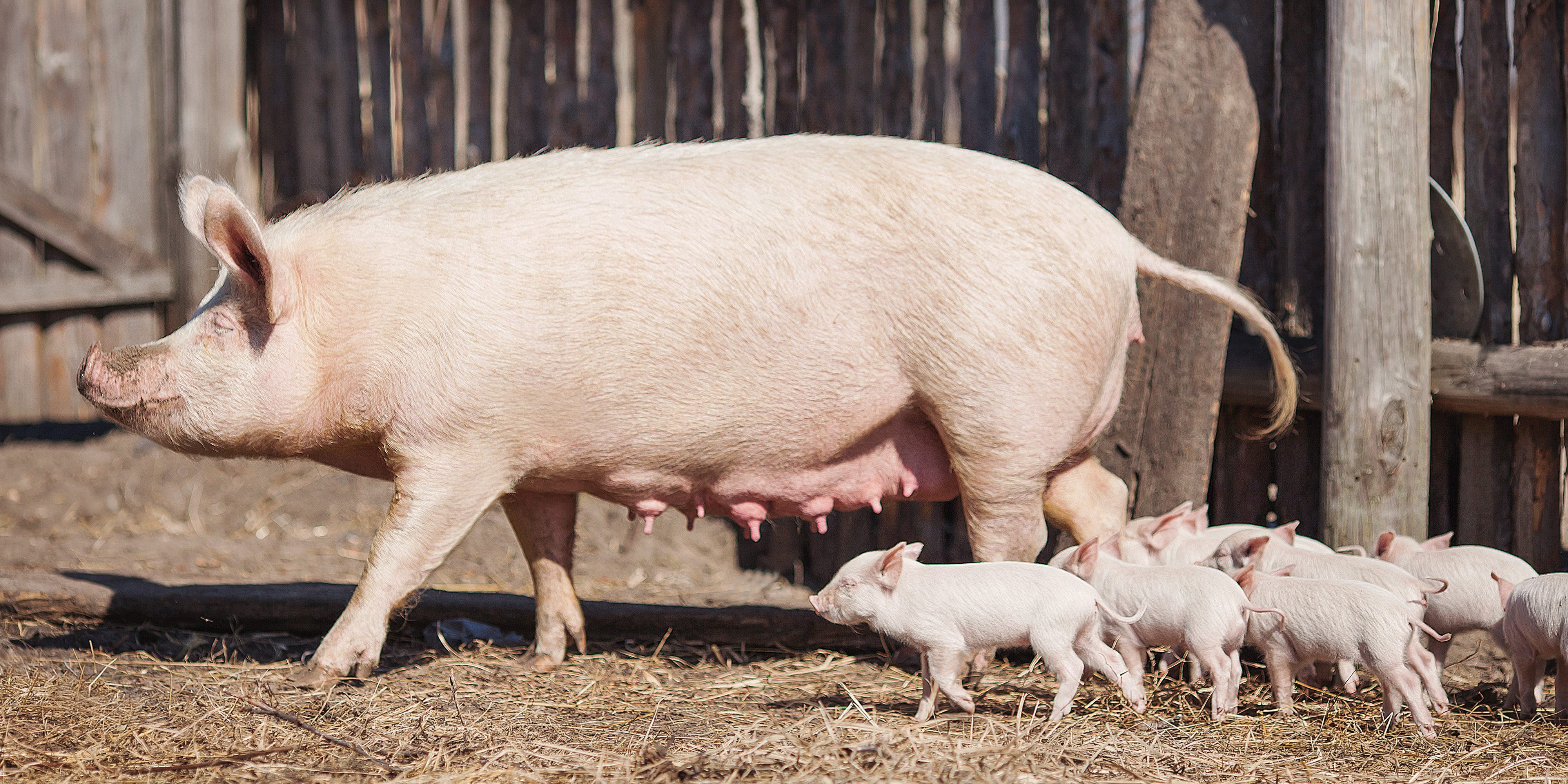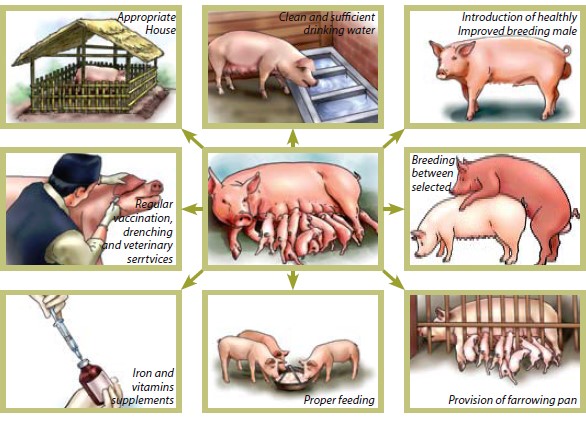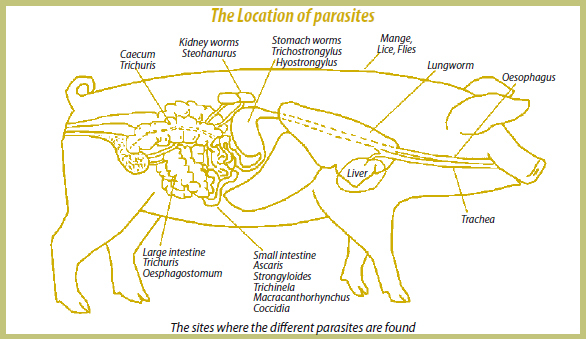



How to Farm Pigs - Feeding
This guide from the FAO provides small scale or backyard farmers information on how best to feed your pigs including diets, equipment and regime.Part of Series:
Next Article in Series >
Editor’s note: The content on this page was written specifically for farmers in Nepal. While much of the information will be applicable elsewhere, please be aware that every country has its own rules regarding feeding animals, e.g. food waste. You must ensure your practices are in line with official regulations in your own region.
Good feed is necessary for growth, body maintenance and the production of meat and milk. You can use locally available feeds that are less expensive, but can be nutritionally complete when properly prepared. In fact, pigs can be fed well using only kitchen scraps from a family’s household. The nutritional needs of pigs can be divided into six categories or classes. These are water, carbohydrates, fats, proteins, vitamins and minerals.

What can you feed your pig?

Commercially prepared swine rations from grain, fruit and vegetable from markets

Vegetable, fruit or bread scraps that have been not in contact with animal products or by-products if they are properly cooked.

Restaurant leftovers, food transporter and disposers of food waste products if they are properly cooked.

Forest Products including wild vegetables, wild bananas, wild cola – cassia, yam, forage grasses etc. if they are properly cooked.

Alcohol distilling residues: local alcohol can be made from millet, rice, maize, sweet potato, banana, etc. if they are properly cooked.
What you shouldn’t feed to your pig

Any meat products: includes pies, sausage rolls, bacon and cheese rolls, pizza, salami and other delicatessen meats and table scraps without proper cooking and screening.

Any carcass or part of a carcass of any mammal or bird (raw and uncooked). This includes any meat blood, offal, hide or feathers. Pigs that feed on carcasses are also at risk of contracting diseases that are contagious to humans.

Any fish products and bones.
The excreta (droppings) of any mammal or bird
Any substance that has come into contact with a prohibited substance via collection, storage or transport in a contaminated container, such as meat trays and take away food containers.
Household, commercial or industrial waste, which includes restaurant waste that hasn’t been properly cooked and screened.
Formulation feed
Creep feed
- Creep Feed is the baby piglets’ first and most important dry food. It contains 20% protein that is highly fortified with milk by-products and is available in small, chewable, highly palatable pellets for easy digestion.
- A combination of protein source, milk replacer, vitamins, amino acids and rich feed ingredients makes this complete feed the ideal start for young healthy piglets.
- Feed ingredients in descending order: corn, soya bean meal, barley, wheat bran, vegetable protein, oilseeds extracts, fatty acids, feed phosphate, pig vitamins, and trace minerals.
- Creep feed (about 20g per piglet per day) or a good home-made mixture with fine rice bran, broken rice and milled maize grains. Clean drinking water must always be available.
Feeds should meet the animal’s needs for maintenance, growth and reproduction. Good pig feed contains sufficient energy, protein, minerals and vitamins. Rice bran, broken rice, maize, soya-beans, cassava, vegetables and distillers’ residues are often used in pig feed.
Distillery waste is much appreciated in traditional pig husbandry, especially for pigs. It is advisable, however, not to give this high valued feed to pregnant and lactating sows or to piglets and weaners, simply because of the alcohol content in the waste.

Rice Bran: This is very suitable for pig feeding. It contains 11% protein and can be used as the main ingredient in most feeds. Rice bran can be mixed with other feeds to 30 - 45%. However, it can be kept for no longer than 1 month because it will become mouldy.

Broken Rice: This is also very suitable for pig feeding. It can be mixed with other feeds up to 15 - 20%. Broken rice contains about 8% protein.

Maize: Thisis a very good animal feed. It contains up to 65% carbohydrates and 9% protein. It can be mixed and cooked with other feeds, but not more than 40% in the mix ration

Soybeans: This is a crop that has a high nutritional value and is very good for pig feeding. It contains 38% protein (very high), and should be dried, milled, or well cooked in combination with other feedstuffs like rice bran, broken rice and maize.

Wheat Bran: Thisis particularly rich in dietary fibre and contains significant quantities of carbohydrate, protein, vitamins, and minerals. Wheat Bran is widely used as a major component in animal feed. It contains Protein 14% - 16%, Fat Max. 9.5%, Crude Fibre 8 - 10% and carbohydrate up to 25%.

Ipil: Leucaena and Acacia are traditional, locally available tree-crops, and the leaves are rich in protein. After drying, they can be mixed and fed to pigs with other feeds.

Root Crops: Thesecan be mixed with other feeds up to around 10 - 20% (never more than 30%). First, the crop should be peeled and washed and then sliced, dried and ground before use. It should not be fed to pigs as raw cassava with the skin, due to the toxic substances present. The sliced and dried cassava can be kept for longer.

Fruits: Fruits damaged during transportation, storage and handling are used as supplementary feeds for pigs by boiling and mixing with other feed such as rice bran, broken rice and maize. They can also be given fresh. Suitable fruits include: bananas, papaya, apples, pears, and melons.

Vegetables: Vegetables damaged during transportation, storage and handling are also used as supplementary feeds for pigs by boiling and mixing with other feeds such as rice bran, broken rice and maize. They can also be given fresh. Suitable vegetables include: cabbage, lettuce, spinach, morning glory, sweet potato vine, cola-cassia (needs boiling), pumpkin, guords, and water hyacinth.

Green Soya bean plant: A reach source of vegetable protein.

Cola-cassia/Pandalu: Leaves and stems are quite a good local protein resources for pigs. Leaves contribute 20% of the dietary dry matter and 46% of the crude protein after cooking. It is also a rich source of calcium, phosphorus, iron, Vitamin C, thiamine, riboflavin and niacin, which are important constituents of a pig’s diet. The fresh tuber has about 20% dry matter, while the fresh petiole has only about 6% dry matter. Leaves and stems have a good composition with high crude protein content (16.51-18.20 % DM basic), and are used as local protein resource for pig production.

Chayote: Both the fruit (vegetable) and the seed are rich in amino acids and vitamin C, potassium, phosphorus and calcium. Fruit is very low in calories (12 calories per 100 g on average), and chayote contains 0.5% protein, 0.2% lipids and 2% sugars.

Banana Stem: The best way of feeding fresh green banana or plantain fruits is to chop them and sprinkle some salt on the slices since the fruits are very low in organic nutrients. Cattle and pigs relish this material. For ensiling purposes, the chopped green bananas or plantains are preferred to the ripe fruits which lose some of their dry matter and, in particular, their sugars during ensiling. Similarly, green fruits are more easily dried than ripe fruits which are very difficult to completely dehydrate.

Pumpkin: Pumpkin is a good source of the vitamin B group, while a large proportion of these vitamins is lost during the preparation of the protein concentrate and isolates.

Bottle gourd: There are important nutritional values in 100 grams of bottle gourd, such as:
- Energy - 12 kacl
- Moisture - 96g
- Protein - little
- Fat - little
- Carbohydrates - 2g
- Fibre - 1g
- Calcium - 20mg
- Iron - little
- Phosphorus - 10 mg

Winter melon (Wax Gourd, White Gourd, Ash Gourd): The Winter Melon is a very large gourd that can grow to up to 50lbs or more. It develops a waxy coating when it matures. Unopened, the winter melon can typically be stored for up to 12 months, but after it is cut open, it can only be stored for a single week.
It contains very low Saturated Fat and Cholesterol, and is also a good source of Thiamin, Iron, Magnesium and Manganese, and a very good source of Dietary Fibre, Vitamin C, Riboflavin, Zinc, and is very high in Sodium.

Clover: Clover’s sodium content is around 0.05%. Crude protein levels in the dry matter are around 25%. Phosphorus is 0.3%, and dry matter digestibility is up to 75%.

Stylo: Stylo is rich in protein, and its DCP levels range from 17 - 24% in green leaf and 6 - 12% in the stem. It grows well in poor soil and can be fed directly to pigs without being cooked (unlike forest plants).

Alfalfa: Althoughlow in fibre, alfalfa is palatable to pigs as well as being easily digestible. It is the best nutritional package you can put into the rations you use to feed your livestock, dairy cattle, poultry or pigs. It also contains a blend of 47 nutritional elements, and provides one of nature’s most liberal balances of vitamins, minerals and amino acids.

Berseem: It is very palatable and is relished by all livestock. There has never been a case of bloat reported if accidentally given an excess amount. It contains 18 – 28% crude protein.

Mulberry: The protein content 89 g/kg dry matter in the fresh foliage of mulberry leaves is well utilized by growing pigs that are fed a basal diet of broken rice.
Traditional Feed Processing
Different feeds are mixed and boiled to make pig feed more palatable. There are 2 types of traditional processing:
- Mixing all the different feeds together (rice bran, broken rice, crushed maize and soya, dried legume leaves, etc.) in proportion and giving it directly to the pigs.
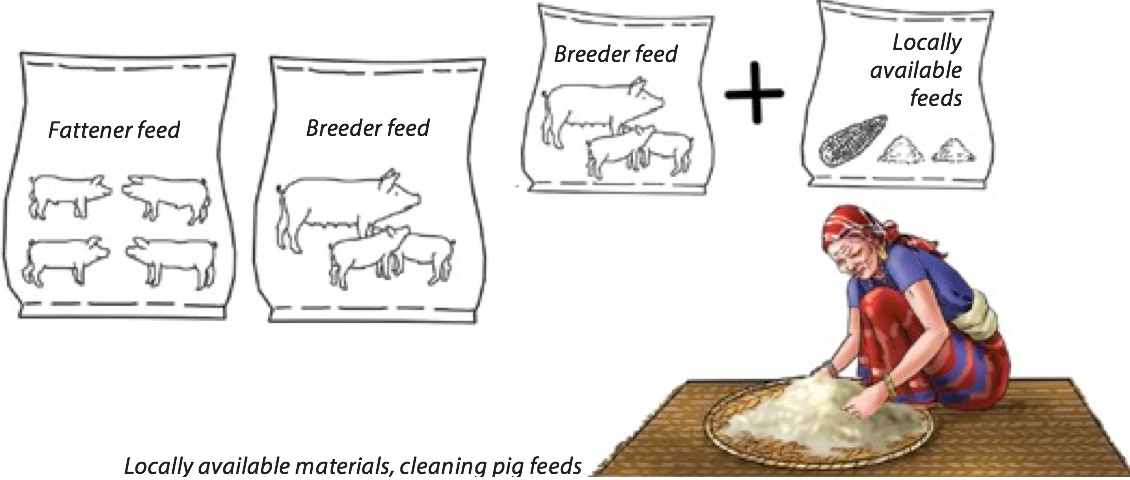
- Cooking the different raw materials together to improve digestibility, and to breakdown toxins from some feeds such as raw cola-cassia, banana stem, maize and soya grains, beans, kitchen waste, forage crops, and similar.
- Food Waste Feeding to Swine is also commonly known as Garbage Feeding or Swill. Food waste or garbage fed to swine must be cooked and sterilized properly.
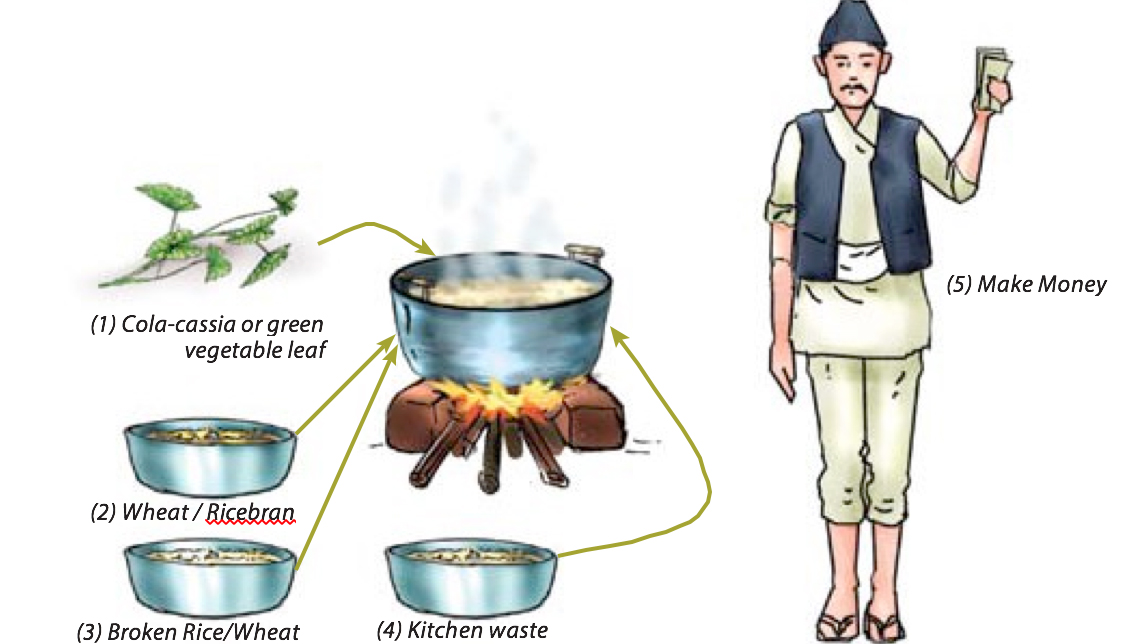
Feeding Forest Products
Pig feed can also be prepared with forest products (wild vegetables, wild bananas, wild cola – cassia etc). At the same time, food waste can be used as well. Currently, growing legumes as feed for village pig production is having a big impact on the livelihoods of rural families in Nepal.
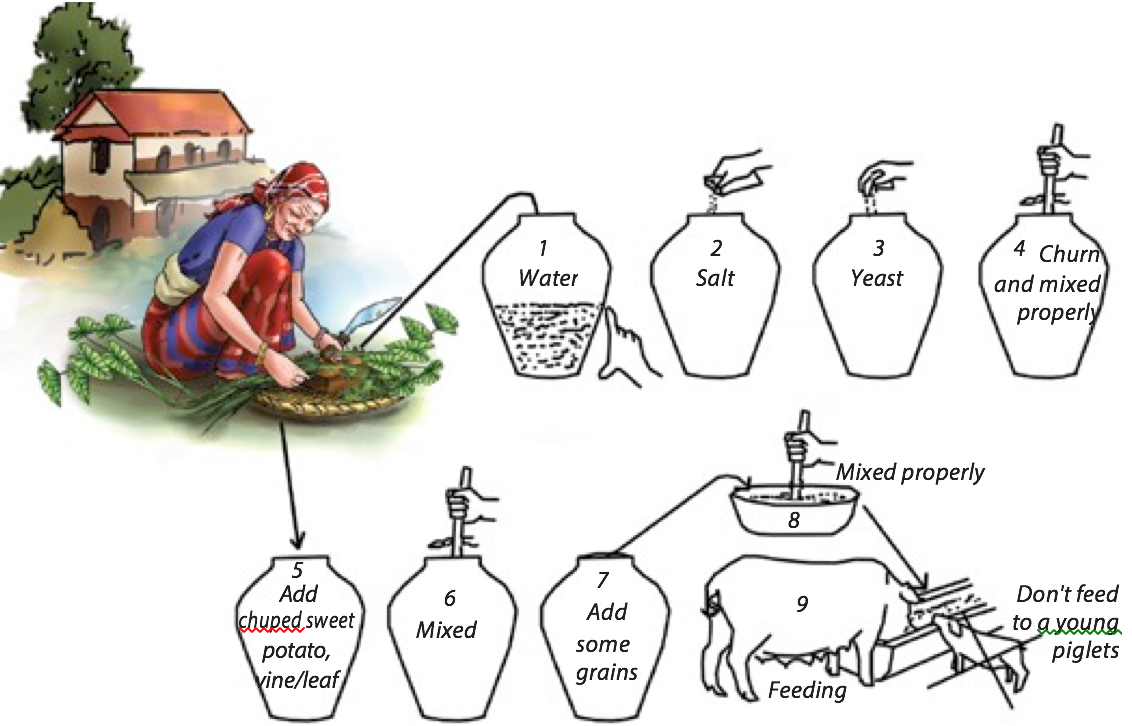
Feeding Alcohol Distilling Residues
Local alcohol can be made from millet, rice, maize, sweet potato, bananas, and similar. Most popular for pig feeding is distillery wastes from millet. It should be mixed with other feeds such as rice bran and broken rice/maize.
Distillers’ residues can be fed to fattening pigs, but not to pregnant or lactating sows. Yet, these animals require a high quality of feed and therefore distillery waste needs to be replaced by other high quality feed such as commercial feeds.

The following mixing ratio is commonly used in combination with distillery waste: Rice bran/Wheat bran (2 kg), broken rice (1 kg), and Distillers’ residues (5-10 kg) and other locally available agricultural by-products.
Local alcohol can be made from millet, rice, maize, sweet potato, yam (Phul Tarul), banana, etc. Most popular for pig feeding is distillery waste from millet and rice, protein content ranged from 17 to 33% (mean of 23%) in dry matter basis. It should be mixed with other feeds such as rice bran, wheat bran, maize/millet flour, and broken rice etc.
Distillers’ residues can be fed to fattening pigs, but not to pregnant or lactating sows. Yet, these animals require high quality of feed and therefore distillery waste needs to be replaced by other high quality feed like commercial feeds.

Daily Feed Requirements
- Dry/pregnant Sows and Gilts: Dry sows and gilts require 2.5kg a day of sow and weaner meal. Give an extra 1kg/day one week before serving gilts and sows and one week after service. Give lactating sows 2.5 kg a day of sow and weaner meal for maintenance and 0.25 kg a day extra for each piglet being suckled.
- Boars: Give boars 2.0 kg a day. If the boar is regularly used increase this to 2.5 kg.
- Piglets: Give creep pellets 0.5 - 1.0 kg a day from day 7 up to weaning time (21 days) per piglet. The feed should be mixed with sow and weaner meal the last one week before weaning.
- Feeding of Growing and Finishing pigs: Pigs weaned at 3 - 5 weeks of 11 - 13 kg body weight should continue being fed on the starter diet until they reach 18 kg live weight. Pigs weaned at 7 weeks or older may be switched gradually to sow and weaner diet.
For growing or finishing pigs all ration changes should be made gradually. If this is not possible the feeding level of the new diet should be low until the pigs become accustomed to it.
Where post-weaning scours are a major problem, restricted feeding during the first week after weaning may reduce the incidents of scours.
For treatment in case of an outbreak of scouring, medication through drinking water is preferable since sick pigs go off feed.

NB: When feeding animals any sudden changes can lead to loss of production. Thus feed changes should be as gradual as possible.
Feeder Trough Size
The feeding trough should be firmly anchored to the floor to prevent overturning and wasting of feed. The size of the feeding trough for different ages and purposes is given in the table below.

Good pig appetite is important. Pigs will eat more fresh clean feed than feed that is contaminated, stale or moldy. To ensure proper intake of nutrition clean feed troughs daily. Sufficient feeder space is necessary, so that each pig can eat what it wishes every day. On many farms feed waste is 15% or more, but it should be avoided as much possible.
Pigs must also be fed on time, since it makes them familiar to the feeding regime. Pigs need to be fed according to their sizes and ages. Troughs must be anchored so they cannot be turned over.
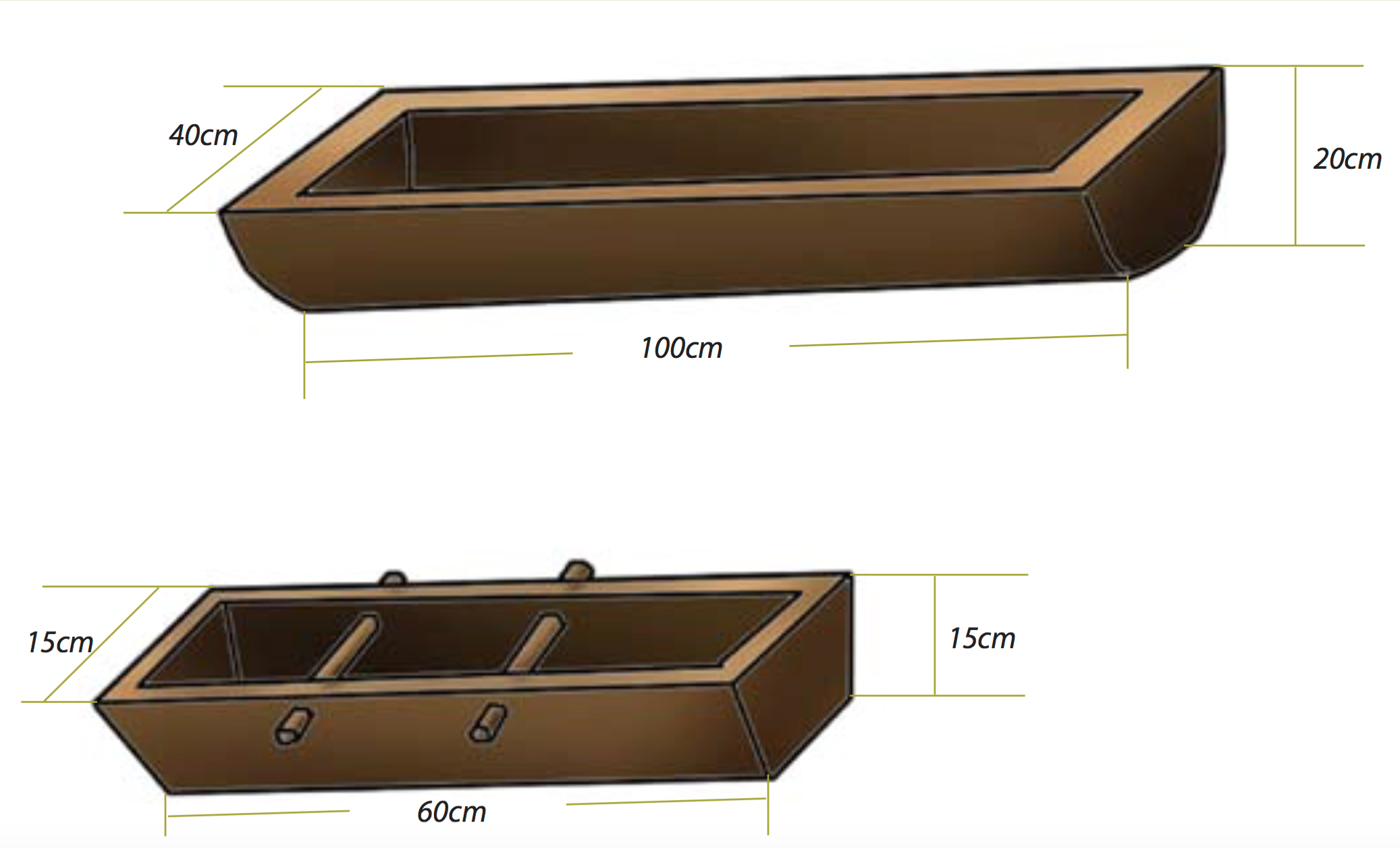
Drinkers
The feeding trough can also be used to supply water. At large farms automatic drinkers are used (called bowls or nipples).
All pigs need sufficient clean drinking water.
- A pregnant sow requires 10 - 12 litres of water per day.
- A lactating sow requires 20 – 30 litres of water per day.
- A growing pig requires 6 - 8 liters of water per day.
- A boar requires 12 - 15 liters of water per day.
By not providing enough water for your pigs you will reduce their daily feed intake. Ample clean water must be available for your pigs to drink at all times.
Also of Interest:
Further Reading
You can view the full FAO Farmer's Hand Book on Pig Production by clicking here.







